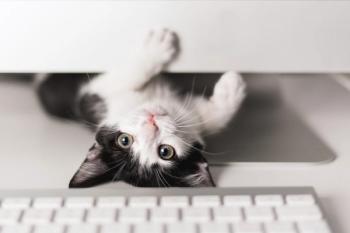
- dvm360 March-April 2025
- Volume 56
- Issue 2
- Pages: 42
Muscle condition scoring in cats
This useful practice can elevate the standard of feline care and allow earlier detection of chronic disease.
Did you know that muscle loss in cats can be an external sign of chronic illness, sometimes even years before other signs are apparent to cat owners? Muscle scoring is a useful practice in feline medicine, and adopting it can elevate the standard of feline care and allow earlier detection of chronic disease. The muscle condition score can be incorporated into medical records the same way the body condition score is with every physical examination.
Body condition score vs muscle condition score
These 2 scores are not the same. Cats can be overweight with increased fat deposits (increased body condition) and have muscle loss (low muscle score). Conversely, cats can also be underweight (low body condition) with normal muscle mass (normal muscle score).1 The goal, of course, is for an animal to have both normal body condition and muscle scores.
How to assess muscle condition score
The muscle condition score is assessed at different sites than the body condition score. To assess the muscle score, start by palpating the epaxial muscles, which are the muscles along the lumbar or thoracic spine on either side.1 This is usually the first group of muscles to atrophy (except for disuse muscle atrophy in a limb).
- Normal muscle score: The vertebral spinous processes (bony projections on vertebrae) are not palpable, even when pressure is applied. They are covered by normal layers of muscle, fat, and skin. One of the indications of feline health is normal muscle scoring.
- Mild loss: The vertebral spinous processes can be mildly palpated.
- Moderate loss: The vertebral spinous processes are moderately prominent on palpation, even without pressure applied. Other bones, such as the scapulae and skull, can also be palpated.
- Marked loss: The vertebral spinous processes are severely prominent. Not only can these bones be easily palpated, but there can be visible indentations along the spine. Other bones, such as the scapulae and skull, are also prominent.
Once muscle loss is identified, the next step is to determine its cause or type.
Types of muscle loss
Sarcopenia is age-related muscle loss in cats 11 years and older without the presence of disease.2 Cachexia is the loss of muscle mass from diseases such as chronic kidney disease (CKD), neoplasia, and congestive heart failure.
In these chronic conditions, amino acids from muscles are used as an energy source more so than fat, and there is usually reduced food intake. Other factors, such as inflammatory cytokines, can also play a role.2
Additionally, cachexia is a negative prognostic indicator for cats with CKD, and it is usually progressive. In one study, cats were found to have weight loss 3 years before CKD was diagnosed.3
Why muscle scoring is important
Muscle loss is an early and visible indicator of internal disease in cats, a species known for instinctively hiding signs of illness. Detecting muscle loss early enables timely intervention, improving outcomes and allowing for dietary adjustments before the underlying condition becomes severe.
The veterinary team and cat owners can be educated about this valuable tool. Teaching staff how to assess and record muscle scores consistently while also helping cat owners understand the significance fosters a collaborative approach to early disease detection and management.
Takeaway
By incorporating muscle condition scoring into routine feline exams, veterinary professionals can detect illnesses earlier, improve treatment outcomes, and enhance the quality of life for their patients. Let’s make this underutilized tool a standard part of feline care.
REFERENCES
- Muscle condition score. World Small Animal Veterinary Association. Accessed March 13, 2025. https://wsava.org/wp-content/uploads/2020/01/Muscle-Condition-Score-Chart-for-Cats.pdf
- Freeman LM. Cachexia and sarcopenia: emerging syndromes of importance in dogs and cats. J Vet Intern Med. 2012;26(1);3-17. doi:10.1111/j.1939-1676.2011.00838.x
- Freeman LM, Lachaud MP, Matthews S, Rhodes L, Zollers B. Evaluation of weight loss over time in cats with chronic kidney disease. J Vet Intern Med. 2016;30(5):1661-1666. doi:10.1111/ jvim.14561
Articles in this issue
7 months ago
Products+Services360: March/April 20257 months ago
Performing a liver biopsy7 months ago
Creating an affordable eco-friendly clinic7 months ago
Dentistry A to Z: "I" is for innovation7 months ago
Fetch Nashville 2025 highlights7 months ago
From the CVO: I'm officially my dogs7 months ago
Caring for honeybees with antimicrobials8 months ago
Clostridial myositis in horsesNewsletter
From exam room tips to practice management insights, get trusted veterinary news delivered straight to your inbox—subscribe to dvm360.






